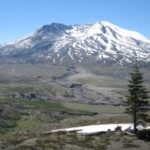The volcano rabbit gets its name from where it lives, which is on volcanic peaks in Mexico. The volcano rabbit is the only known rabbit to live on or near any volcano in the world. Because of its uniqueness the volcano rabbit is in need of some sort of government protection to protect the species so that there does not come a day when we say yes, there used to be a rabbit that lived in volcanoes, we called it the volcano rabbit but we let it die off and become extinct.
Physical Characteristics
The volcano rabbit is 9 to 12 ½ inches long with a 3/8 to 1 /14 inch long tail and weighs 13 to 21 ounces. Its ears are very short and rounded compared to most rabbits. Its back legs and feet are small. The fur of the volcano rabbit yellowish with black guard hairs. Its torso is light buff with a Gray under fur. The ears are also buff colored.
Behavioral Characteristics
The volcano rabbit lives in groups of 2 to 5 individuals. It uses shrill whistles for communication. It has at least 5 different calls. It takes shelter in burrows it makes among tall, dense grass. These burrows can extend as far as 5 meters long and are up to 40 cm deep underground. The entrance is hidden by a clump of grass. Nests are made by this species from April to September. Nests are lined with fur and plant fragments. Nests are comprised of merely a shallow depression hidden under a clump of grass. The most active times of day for this animal is the evening and the early morning.
Life Cycle
The volcano rabbit does not have a set breeding season. They are able to breed all throughout the year. They do, however, experience a peak in breeding during the summer when it is warm and rainy. Gestation or pregnancy is 38 to 40 days long. Litters may contain 1 to 3 offspring. The offspring are born with their eyes closed but they have all their fur. The suckle for only about 2 weeks. A week after weaning they separate from their natal group.
Diet
The volcano rabbit is completely herbivorous. It eats mainly grass, especially the tall, dense grass that is prevalent around its range. It prefers the leaves of grass rather then the stalk. They sometimes also eat herb leaves and alder bark. Only during the rainy season to they add cultivated oats and corn to their diet.
Habitat
The volcano rabbit is found in central Mexico. It inhabits the open pine forests located on the volcanic peaks near Mexico City. Its range is part of what is known as the Mexican trans-volcanic belt. This habitat of open pine forests has dense bunch grasses and is called zacaton.
Conservation Status
The volcano rabbit is classified as endangered on the IUCN (International Union of Conservation of Nature and Natural Resources) red list of threatened species. It has only a single small range of about 386 square kilometers that is becoming increasingly more fragmented.
References:
Animal: The Definitive Visual Guide to the World’s Wildlife by, David Burnie and Don E. Wilson
Jansa, S. 2002. “Romerolagus diazi” (On-line), Animal Diversity Web. Accessed August 31, 2009 at http://animaldiversity.ummz.umich.edu/site/accounts/information/Romerolagus_diazi.html.
http://www.iucnredlist.org/details/19742/0





